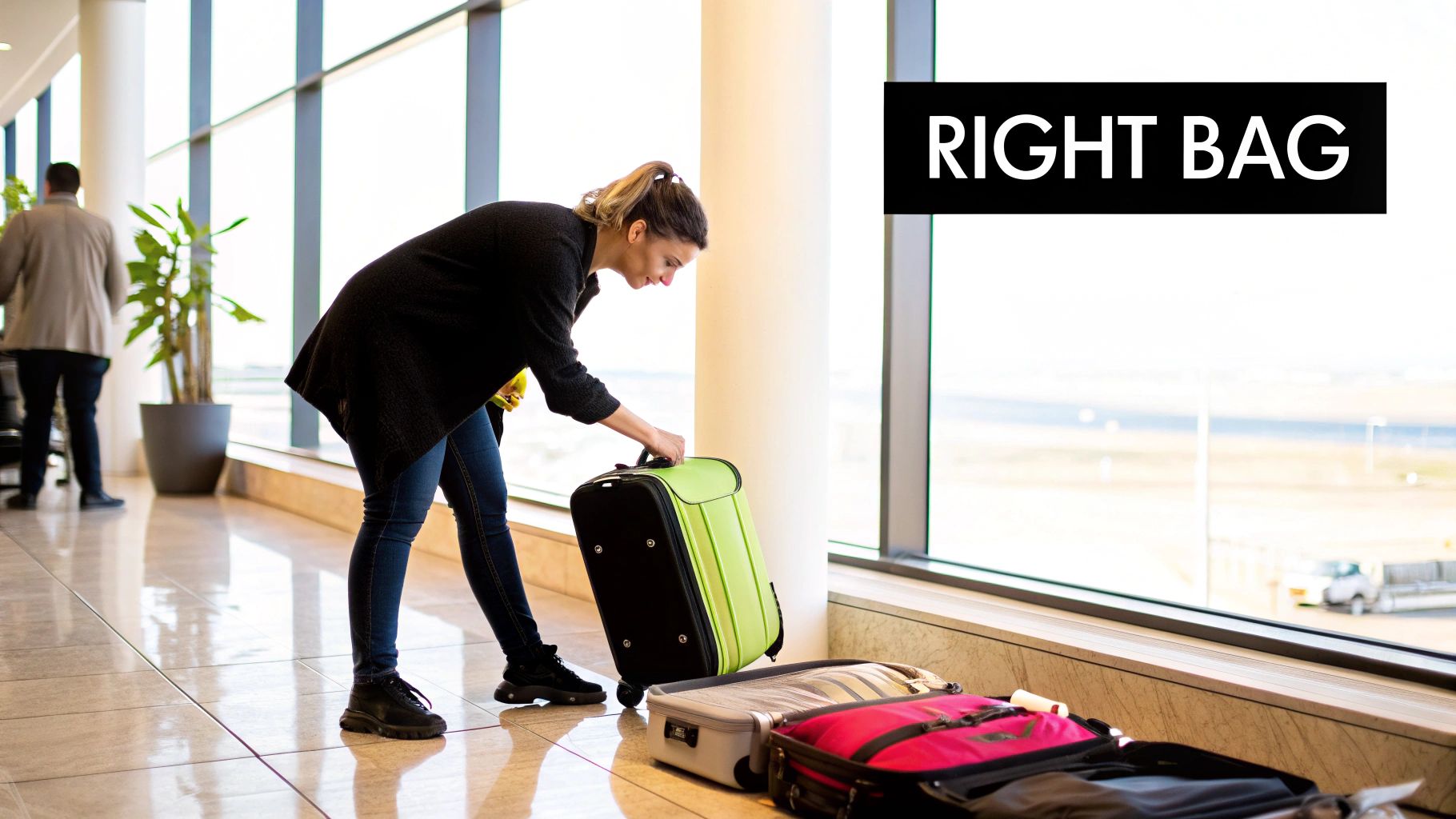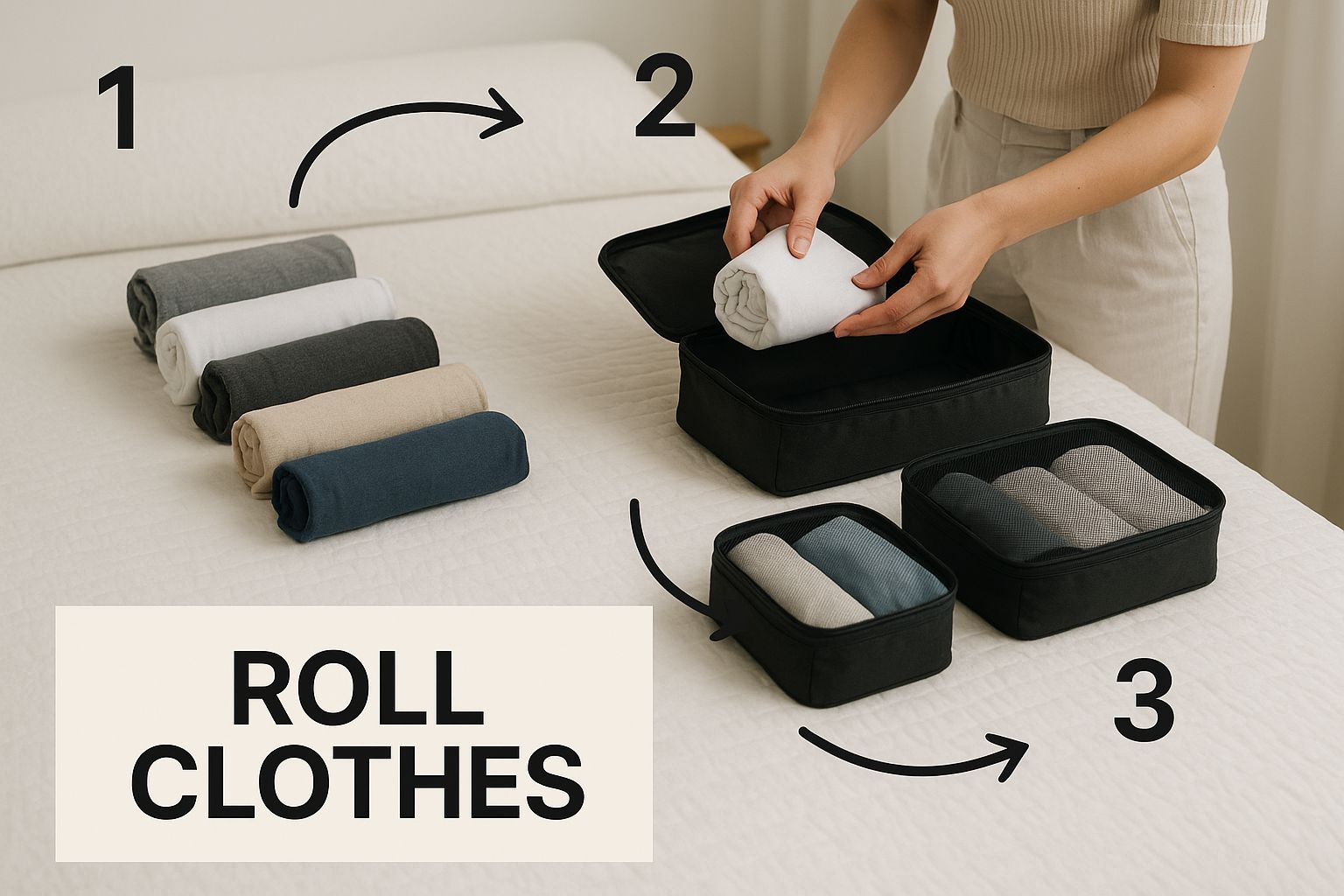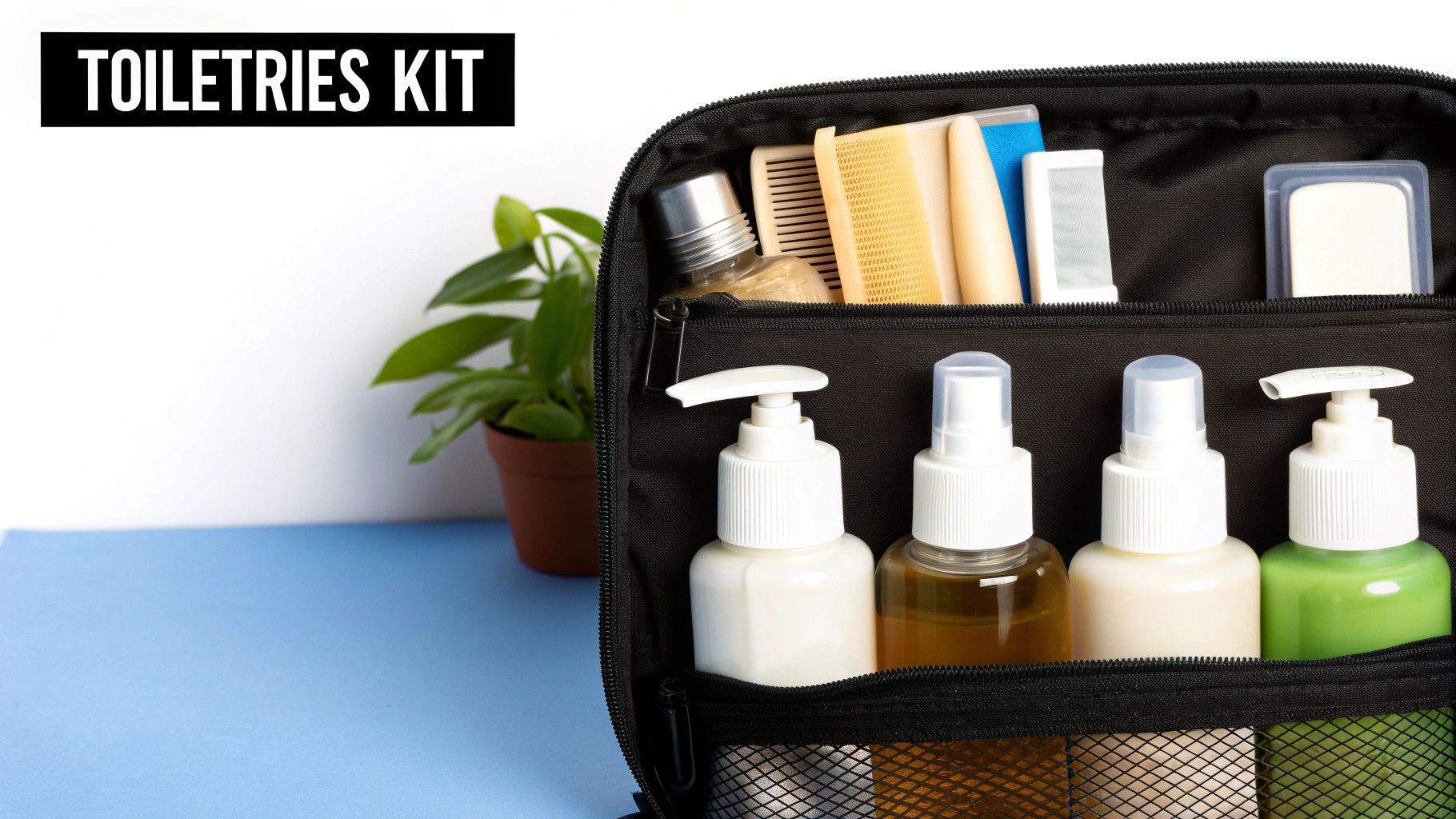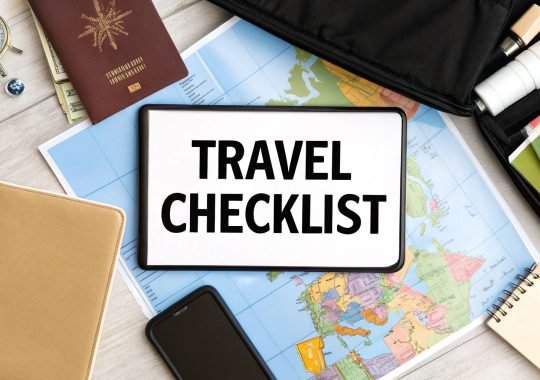Smart packing has less to do with your suitcase and more to do with your mindset. The real secret is to plan your wardrobe around your destination and activities, creating a tight, versatile collection of clothes where every single piece pulls its weight. This strategic thinking is what stops overpacking in its tracks and is the true foundation for lighter, easier travel.

Build Your Packing Strategy Before You Start
I see it all the time—people treat their suitcase like a storage unit for every “just in case” item they can imagine. But an efficient packer thinks like a curator, not a collector. The goal isn’t just to cram everything in, but to bring only what you’ll genuinely need and love to wear.
This whole process kicks off with a little bit of research. Of course, you’ll check the weather forecast, but don’t just stop there. Think about the microclimate. A city on the coast might be warm and sunny during the day, but that ocean breeze can make evenings surprisingly cool.
Your planned activities are just as important. A week spent hiking mountain trails demands a totally different wardrobe than a week of museum-hopping and fine dining in a city like Paris.
Create A Travel Capsule Wardrobe
This is the holy grail of efficient packing. A capsule wardrobe is simply a small, curated collection of items that all mix and match, allowing you to create a ton of different outfits. Instead of packing separate, pre-planned outfits for every single day, you pack complementary pieces that work together seamlessly.
A great rule of thumb for a week-long trip is what I call the “3-3-3” rule: pack three tops, three bottoms, and three layering pieces (like a sweater, jacket, and scarf) that all coordinate. This simple formula gives you dozens of potential outfits from just a handful of items.
Ready to build your own? Here’s how to approach it:
- Stick to a Color Palette: Start with neutral base colors like black, navy, or tan. Then, throw in one or two accent colors that pop. This is the easiest way to guarantee everything looks good together.
- Prioritize Versatility: Every item should earn its spot. Pack pieces that can be dressed up or down. That simple black t-shirt you wear for sightseeing? Pair it with a nice scarf or a blazer, and you’re ready for dinner.
- Focus on Smart Fabrics: As you pull pieces, think about fabric. Items like quick-dry travel underwear can be a game-changer, reducing bulk and making it easy to do a quick sink-wash on the go. To keep your whole trip organized, I also recommend grabbing some of the essential travel apps that help with everything from itineraries to translations.
Choosing the Right Luggage and Organizers
Your luggage and organizers are the foundation of any efficient packing plan. I’ve learned the hard way that the suitcase itself can make or break your packing strategy, long before you even think about rolling a single t-shirt.
The hardshell versus softshell debate is a classic for a reason. Hardshell suitcases offer incredible protection, which is a lifesaver if you’re traveling with fragile souvenirs. On the other hand, softshell bags give you more flexibility, with those handy external pockets that are perfect for stashing last-minute items or travel documents. Your choice really comes down to your trip and what you value more—protection or flexibility.
When you’re figuring out your travel setup, looking at a range of suitable bags and backpacks is a must. A quick week-long city break might only need a trusty carry-on, but a multi-destination adventure will probably call for a larger checked bag.
The Power of Packing Organizers
Once you’ve picked your main bag, it’s time to bring in the real game-changers: packing organizers. These aren’t just trendy accessories; they are essential tools for anyone serious about staying organized and maximizing every inch of space.
Packing cubes are my absolute non-negotiable. They don’t just group your clothes into neat little bundles—they compress them, freeing up a surprising amount of room. I always use separate cubes for tops, bottoms, and underwear. It makes finding things a breeze.
Beyond cubes, a few other organizers are crucial for a stress-free trip:
- Toiletry Bags: A high-quality, leak-proof toiletry bag is non-negotiable. It’s the best defense against the dreaded shampoo explosion all over your clothes.
- Shoe Bags: These are simple but effective. They keep the grime from your shoe soles off your clean clothes.
- Electronics Pouches: A dedicated pouch for chargers, adapters, and cables prevents that tangled nest of wires we all know too well.
Choosing the right container has a massive impact, a principle that even scales up globally. It’s interesting to see that in 2023, the worldwide packaging industry saw rigid plastics make up 31.4% of materials, while flexible packaging accounted for 30.5%. This balance between structure and adaptability is exactly what you should be aiming for when picking out your own luggage and organizers.
To help you decide what’s best for your travel style, here’s a quick comparison of the most common packing aids.
Packing Aid Comparison
| Packing Aid | Primary Use | Best For |
|---|---|---|
| Packing Cubes | Compressing & categorizing clothes | Organizing clothing by type (shirts, pants, etc.) and saving space. |
| Toiletry Bag | Storing liquids & personal care items | Preventing spills and keeping all your bathroom essentials in one place. |
| Shoe Bags | Separating dirty shoes from clothes | Keeping your luggage clean, especially after hiking or walking in the rain. |
| Electronics Pouch | Organizing cables, chargers, & adapters | Preventing tangled wires and protecting small gadgets. |
Ultimately, the goal is to create a system that works for you. Whether you go all-in on packing cubes or just use a simple shoe bag, these small additions will completely change how you pack.
Mastering Proven Space-Saving Techniques
Once you’ve curated your travel wardrobe, the real puzzle begins: getting everything into your suitcase without it exploding. This is where a few key techniques can completely change your packing game. I’ve heard the folding versus rolling debate a thousand times, and after years of travel, I can tell you the answer isn’t one or the other—it’s both.
Rolling is your absolute best friend for most of your casual clothes. Think t-shirts, jeans, leggings, and knit sweaters. When you roll them tightly, they become incredibly compact. Not only does this save a ton of space, but it also surprisingly helps minimize wrinkles in those more durable fabrics. The trick is to fold the item in half lengthwise first, then roll it up as tightly as you can from one end to the other.
This is what I mean—see how rolling turns your clothes into neat little logs? They become perfect for tucking into every nook and cranny of your luggage.

As you can see, this simple method makes your clothes so much easier to stack and organize. No more digging through a messy pile to find one shirt.
Advanced Methods For Tricky Items
But here’s the thing: you shouldn’t roll everything. For items that are more structured or wrinkle easily—like blazers, crisp dress shirts, or linen pants—folding is still the way to go. A clean fold along the garment’s natural seams will prevent those awkward, hard-to-iron creases that rolling can cause on more delicate materials.
For your most precious, wrinkle-prone outfits, there’s a technique I swear by called bundle wrapping. It’s a true game-changer. You start with a small, soft item at the core (like a pouch of socks or a rolled t-shirt) and then you carefully wrap your larger, delicate items around it, one by one. The gentle tension created by the bundle keeps everything smooth and virtually wrinkle-free upon arrival.
Start with your most wrinkle-resistant items on the inside and finish with the most delicate ones on the outside layer. This method cocoons your formalwear, ensuring it arrives looking fresh.
Now, for the biggest space hogs: bulky winter wear. If you’re heading to a cold climate, things like ski jackets, puffer vests, and heavy sweaters can feel impossible to pack. This is where vacuum-sealed bags become your secret weapon. When you use them right, they can shrink the volume of these items by up to 50%. Just a word of caution: don’t overstuff them, and it’s a good idea to leave them slightly unsealed when going through airport security, as the pressure changes can sometimes cause them to re-inflate.
If you’re looking to really perfect your system, there are plenty of other packing tips out there that can help you fine-tune these methods. By strategically combining rolling, folding, bundling, and a bit of compression, you’ll be packing like a pro in no time.
How to Strategically Load Your Suitcase
Now that your clothes are rolled and your packing cubes are ready to go, it’s time for the real puzzle: loading the suitcase. How you arrange everything inside is just as critical as how you prepared it. I always think of it like a game of Tetris—the goal is to create a dense, stable block with absolutely no wasted space.
The first rule I live by is simple: heavy to light. Your heaviest items should always go at the bottom of the suitcase, right over the wheels. This is where I put my shoes, my toiletry kit, and any books I’m bringing along. Placing the weight at the base creates a lower center of gravity, which stops the bag from constantly tipping over. It’s a small trick that saves a ton of frustration when you’re rushing through an airport.
Fill Every Available Gap
With the heavy stuff in place, you can start building your layers. I begin by laying the largest packing cubes flat to create a solid foundation. From there, I slot the smaller cubes in and around them, fitting them together like a set of bricks. This method is the key to preventing the dreaded “packing shift,” where all your carefully organized items slide into a jumbled mess at one end.
Don’t just pack your items—pack the air right out of your suitcase. Every tiny, empty space is an opportunity. A well-packed bag is a solid bag where nothing can move around.
Once the main “bricks” are in, it’s time to get creative and fill the gaps. This is where you truly master efficient packing and use every last inch of space.
- Stuff Your Shoes: I never let the space inside my shoes go to waste. They’re basically bonus containers! I always stuff them with socks, underwear, or even small electronics like chargers and adapters.
- Use the Perimeter: The outer edges of your suitcase are perfect for tucking away long, thin items. This is where I slide my belts, a slim travel umbrella, or a pair of flip-flops.
- Nestle Fragile Items: If you’re bringing back any delicate souvenirs, wrap them in a soft piece of clothing (a sweater or hoodie works great) and place them right in the center of the suitcase. The surrounding packing cubes will cushion them from all sides.
Navigating Airport Security: A Guide to Packing Electronics and Liquids

Let’s be honest, the two things that cause the most stress at airport security are electronics and liquids. A tangled web of chargers or a surprise shampoo spill can turn a smooth travel day into a frantic mess. With a little bit of smart prep, you can breeze through the checkpoint.
Keeping Your Gadgets Organized and Safe
First up, the electronics. That tangled nest of wires at the bottom of your bag? We’ve all been there. My absolute must-have is a dedicated electronics organizer. It’s a simple pouch that corrals all your chargers, power banks, and adapters into one spot. No more frantic digging while the security line waits.
For more fragile gear like a camera or tablet, never just toss it in. I always make sure to place these items right in the middle of my suitcase, creating a protective buffer with soft clothes. Think of your sweaters and t-shirts as built-in shock absorbers that shield your tech from bumps and drops.
The Art of Leak-Proof Liquids
Liquids are a whole different ball game, with TSA rules and the constant threat of a leak. The rules are non-negotiable for carry-on: all liquids must be in travel-sized containers (under 3.4 ounces or 100 milliliters) and fit into a single, clear, quart-sized bag.
Here’s a pro tip that has saved my luggage more than once: before screwing the cap back on your shampoo or lotion, place a small piece of plastic wrap over the opening. This creates an extra seal that’s surprisingly effective against spills.
This idea of smart, efficient packaging is a big deal everywhere. In 2023, global plastic production reached about 414 million metric tons, with a huge chunk used for packaging. Industries are catching on, with flexible plastics now making up 30.5% of packaging because they save so much space and weight. You can see more on these global production trends on Statista.com.
Finally, always tuck that clear bag of liquids into an outer pocket of your carry-on. That way, you can grab it in seconds for the security screening without having to unpack half your bag in front of everyone. It’s a small move that makes a huge difference.
Your Last-Minute Packing Checklist
Even the most organized packer can get caught up in the final rush to get out the door. Before you zip that bag shut for good, it’s worth taking just a couple of minutes for a final mental scan. Think of it as your personal safety net for a completely stress-free departure.
First up, the absolute non-negotiables. Do you have your passport, visas, and any other required travel documents? I always put mine in a secure but easy-to-reach pocket. It sounds ridiculously obvious, but you would be shocked at how many times I’ve seen people frantically patting their pockets at the check-in counter. Don’t be that person.
Next, shift your focus to health and comfort for the journey ahead. Are all your prescription medications accounted for? I also never leave without a simple first-aid kit with basics like pain relievers and bandages. Crucially, I make sure my portable charger and any necessary adapters are tucked into my carry-on, never the checked bag. There’s honestly nothing worse than landing with a dead phone and no way to navigate or contact your hotel.
This final check is all about peace of mind. It takes less than two minutes but can save you from massive headaches later on. Knowing your wallet, house keys, and printed hotel confirmations are on you lets you walk out the door feeling ready for anything.
Finally, do one last sweep for those small, easy-to-grab items that make travel so much better. I’m talking about headphones for the plane, a reusable water bottle to fill up post-security, and maybe a packable scarf for those notoriously chilly cabins. It’s this quick, final once-over that nips all those “Oh no, I can’t believe I forgot…” moments right in the bud.
Common Packing Questions Answered
Even the most seasoned travelers run into nagging little questions when it’s time to pack. Sometimes, having a quick answer to those last-minute doubts is the key to a smoothly packed bag. Let’s tackle a few of the ones I hear the most.
So many people ask how to stop themselves from overpacking clothes. My go-to strategy is to think like a stylist and build a mini capsule wardrobe for the trip. I always start with a simple color palette—think neutrals like black, tan, or navy, plus one or two accent colors. This simple trick ensures every top you pack works with every bottom, giving you way more outfit options without the extra weight.
The “5, 4, 3, 2, 1” rule is a brilliant guideline for a week-long trip. Try to pack no more than five tops, four bottoms, three accessories or layers (like scarves or cardigans), two pairs of shoes, and one specialty piece, like a swimsuit or a formal jacket.
Are Packing Cubes Really Worth It?
I get this question all the time, and my answer is always a resounding yes. It’s easy to think packing cubes are just another travel gimmick, but trust me, they are a genuine game-changer. They don’t just organize your suitcase; they actually compress your clothes, creating a surprising amount of extra space.
Here’s why I swear by them:
- Easy Categorization: I group similar items together—all my shirts in one, underwear in another, electronics in a third. This means no more digging through a perfectly packed suitcase just to find a clean pair of socks.
- Major Space-Saving: By squishing the air out of your clothes, they seriously cut down on bulk. This is especially true for the compression-style cubes, which can free up an incredible amount of room for souvenirs on the way home.
Finally, the ultimate question: how to keep clothes from getting wrinkled. For delicate items like a linen blazer or a silk dress, bundle wrapping is an unbeatable technique. For just about everything else, rolling your clothes tightly is a fantastic way to minimize creases while saving a ton of space. It’s a win-win.




